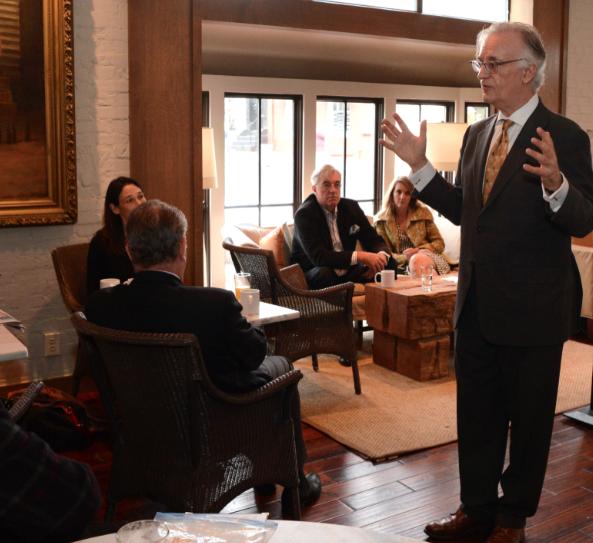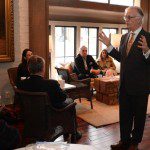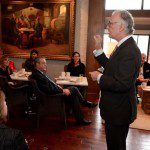Freer-Sackler’s Raby: a Studious Man Firmly in the World of Art—and the World
By • November 16, 2015 0 2200

Sometimes, we forget just how lucky we are to be living in Washington—never mind the presence of politicians.
We have the zoo, the National Gallery, museums new and old, we have the mall, we have art and artists and their explainers and caretakers, we have places and people so unique and singular as to qualify as treasures.
And we have the Freer|Sackler Galleries, the Smithsonian’s Museums of Asian Art.
We have Julian Raby, the Director of the Freer Gallery of Art and the Arthur M. Sackler Gallery since 2002. He was the second speaker in the Georgetown Media Group’s second season of its Cultural Leadership Breakfast Series at the George Town Club Nov. 5.
If, in the midst of a crowd, you had to pick out a man who might have the touch of an antiquarian, an Oxford graduate, an author, lecturer and expert on Asian and Islamic art, who spends many of his waking hours in the presence of works of art from across the globe itself, you’d probably hone right in on Raby, even before he said a single word. He has the air of an explainer, the grace of a man who carries enough knowledge to water numerous university gardens without making a show of it. You would just say,“that’s the one.”
Raby, 65, had his passion on display before the attendees at the breakfast. You got not only the history of first the Freer and then the Sackler, but the personalities and quirks of James McNeill Whistler, the rise of art in America in a particular place and time, and the role of the artist in it. He explained the importance of the collections among the sister museums, their mutual mission to “expand knowledge” and the importance of the arts of foreign lands, civilizations and times.
Ask Raby a question, and he speaks not in slogans, but in punctuated and grammatical sentences, in whole paragraphs, and probably in tongues and tomes as well. He is impressive without being intimidating. He is, these days, also a man concerned with antiquities and art that are being threatened by destructive, nihilistic forces in the Middle East, where 2,000-years-old structures and objects that make up ancient Palmyra in Syria are all but destroyed.
“What we do and can do is very important,” he said, “living as we are in a time of increasing intemperance and hostilities which threaten the preservation of our historic past.”
Raby brought to life the beginnings of the Freer Gallery, the first museum of art on the National Mall (dedicated in 1923), spawning from the ideals of its founder, Charles Lang Freer, a full-cloth American self-made man.
“There was no silver spoon in the mouth of Charles Lang Freer,” he said, noting his beginnings as a maker and developer of railroad cars, which made him nearly a billionaire and allowed him to retire at age 47. He also had the good fortune, spurred by an interest in art collecting, to meet and be associated with Whistler from whom he at first bought just a modest etching.
“The relationship was an extraordinary match,” Raby said. “Whistler was choleric, quixotic, and Freer was an extremely thoughtful man.It was a match that would lead to the acquisition of 1,300 works which formed the foundation of the collection and started a passion in Freer, and even obsession, with Asian Art and culture, prints and screens, and with China.”
Freer endowed the museum with his collection—some 7,500 works.
Freer also endowed his passion for Asian art to Teddy Roosevelt, who understood the developing significance of the East and Far East to the culture, trade and global politics of the United States.
The fascination with Asian art, and then Islamic art, on the part of Freer was an expression, “of the universality of art,” Raby said. “There was a view that art had a core spirituality, that it could be therapeutic.”
The Freer Gallery became a part of the Smithsonian, which by a famous phrase was, “a collection of objects,” and included “that musty phrase and description, ‘the nation’s attic,’” Raby added.
Initially, the Freer Gallery was a “closed institution.” There was to be no lending or borrowing, but it is now a haven for scholarly work and research.
If you listen to Raby talk, you can see how he perceives the museum and its purpose. “There is a responsibility here, and an opportunity, it has always done so—the responsibility to help create empathy and understanding across the cultures, to gain a respect for other cultures,” he said.
That respect and love arises in his description of the famed Peacock Room, made for British shipping magnate Frederick Richards Leyland by Whistler. “Imagine,” Raby said, “a relationship somewhat like what Velasquez might have had with the hidalgos.” A phrase you won’t hear every day.
“It’s not what it used to be, but when we open the windows and let the light in, it’s still spectacular.”
There are times—when he talks about “magical buildings,” about Orientalism and antiquity, about great discoveries of beautiful objects from lost civilizations—when Raby sounds like a pied piper, a master of the dance of appreciation. He has been in Washington since the 1980s, a city that he obviously loves. “Living in Georgetown is a privilege,” he said. “It’s a beautiful place.”
He is as alarmed as any museum director and caretaker of antiquity about the already disastrous damages that have been done to towns and places in the Middle East.
“It is of course terrible, but it’s not just about ISIS, it is about everything, natural disaster, wars. We have to do more than merely lament losses, we have to prevent further losses. People—museum directors—are working on protocols to create safe havens where objects of art and antiquity can be stored in a kind of interim time, until this is over. But there is this: In some ways, all of these things are part of memory, safely stored there in our minds. In some ways, in this age, nothing disappears. We must make sure that things remain that way also.”
For a man who deals so much with the remnants and glories of the past, Raby is excited about the future: “This city, and other cities, are changing. It’s becoming younger, smarter. It’s losing some of that stiffness. We can look at new ways to appreciate and display, to show all the beauties of cultures from all over the world.”
- Julian Raby at the George Town Club Nov. 5 | Photo by Neshan H. Naltchayan



